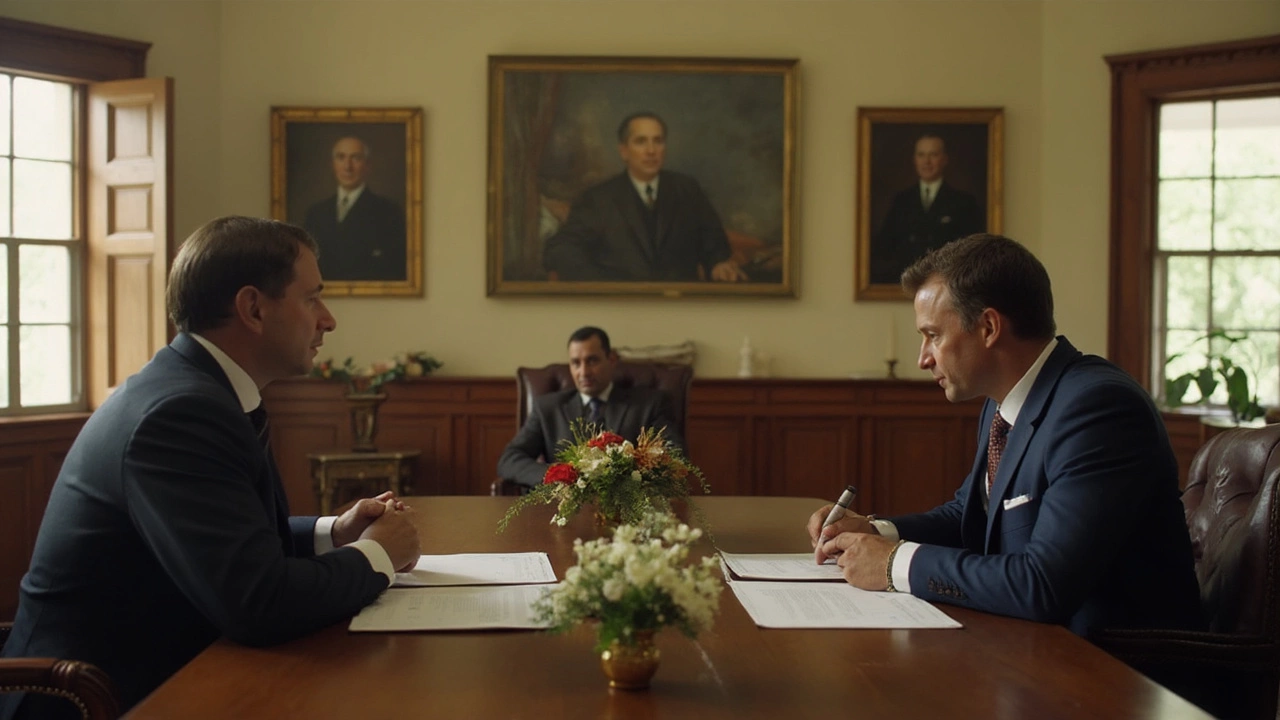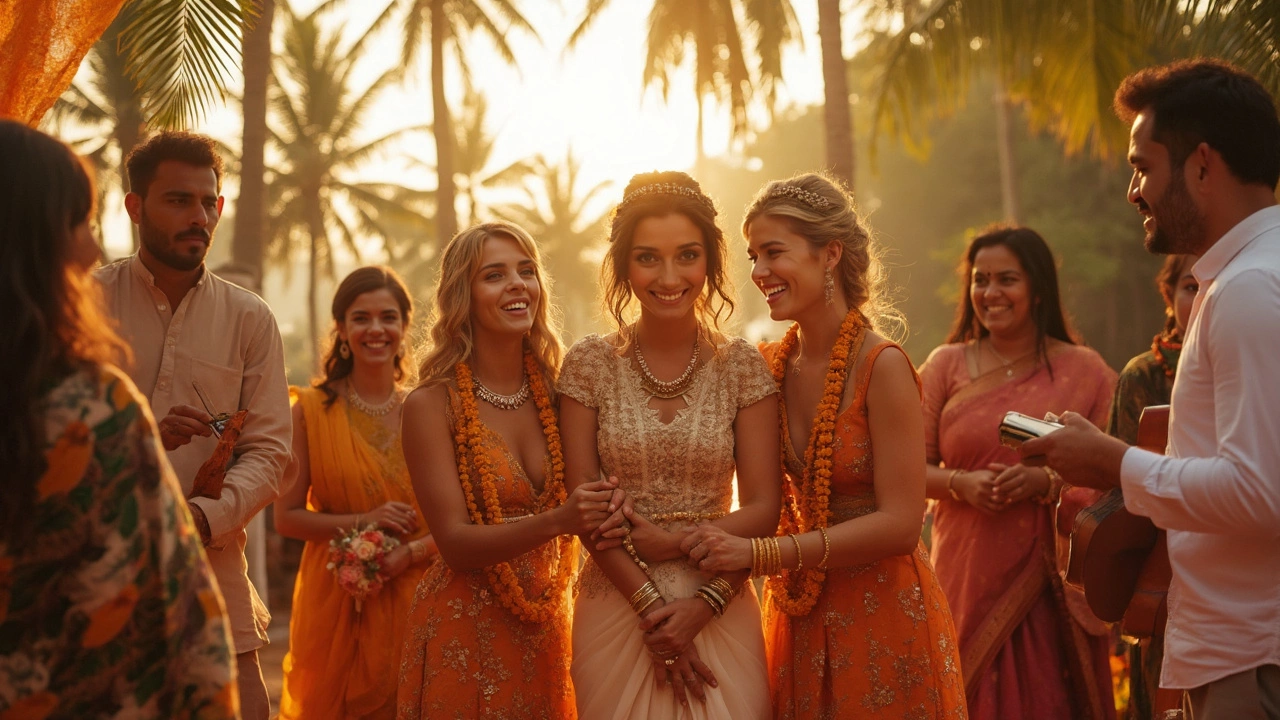The idea of two Americans saying their vows in India sounds awesome—it’s not just Bollywood fantasy. But what’s the real deal when it comes to the legal side? India actually lets foreigners get married here, even if neither person is Indian. The process isn’t as quick as in Vegas, though, so don’t expect to waltz into a courthouse and walk out married an hour later.
First thing to know: the law is pretty specific. You can get married under the Special Marriage Act, which works for two foreigners. But here’s the kicker—there’s a waiting period and a bunch of paperwork you can’t skip. Indian officials love documents, and you’ll need originals and copies of pretty much everything you can think of: passports, visas, birth certificates, proof you’re not already married, and a ton of passport-sized photos.
One detail that always surprises people—before you can actually marry, you have to file an official notice with the local registrar, and then wait 30 days. Yes, thirty. This gives them time to see if anyone objects to the marriage (sounds old-school, but it's just how it's done). If you’re not hanging around for a month or planning ahead, this can derail your plans fast.
- Legal Basics for Foreign Marriage in India
- Required Documents and Steps
- Types of Weddings: Civil vs. Religious
- Practical Tips for a Smooth Experience
Legal Basics for Foreign Marriage in India
If you’re asking if two Americans can get legally married in India, the answer is yes, but not by default Indian tradition or just any ceremony. You both have to follow the Indian Special Marriage Act, 1954. This law covers foreign couples and even two non-Indians who want a legally recognized marriage on Indian soil. The process is paperwork-heavy and not designed for spontaneous elopements, so get set for some bureaucracy.
The marriage registration process starts by giving a written notice to the local Marriage Registrar. Neither of you needs to be an Indian citizen, but one of you must be living in India for at least 30 days in the district where you’ll apply. This part can throw off your timeline—don’t count on squeezing your wedding in during a week-long trip.
Once you file your notice, the registrar puts your names up on a public notice board at the marriage office for 30 days. This is so anyone who might object (almost never happens for foreigners) can speak up. If nobody objects, the registrar schedules your official marriage date after that 30-day waiting period. You’ll sign the marriage documents together, and boom—it’s official in the eyes of India.
Here’s what the timeline generally looks like:
| Step | How Long It Takes |
|---|---|
| Residency in application district | 30 days minimum |
| Notice filing | Same day |
| Notice period | 30 days |
| Marriage registration ceremony | After notice period |
Bottom line: you can totally get married as two US citizens in India, but plan for a couple of months, not a quick trip. Skipping paperwork or the waiting period isn’t really an option—Indian officials don’t make exceptions for foreigners, and it’s not worth risking your marriage legality back in the US.
Required Documents and Steps
Alright, let’s break down what two US citizens really need to pull off a legal wedding in India. The main thing to keep in mind: there’s lots of paperwork, and skipping steps can get your application tossed back.
Here’s a list of what you need for marriage registration as foreigners:
- Valid passports and Indian visas (tourist, business, or entry type—wedding visas aren’t a thing)
- Birth certificates, preferably with parents’ names listed
- Proof of single status for both of you, called an 'Affidavit of Marital Status.' In most cases, you’ll get this notarized at the US Embassy or Consulate within India
- Address proof in India—often your hotel booking, a letter from a landlord, or a friend if you’re crashing with someone
- Passport-sized photos—about six each is safe
- If either of you was married before, you’ll need official divorce or death certificates
All documents not in English should have official translations and might need to be apostilled. This step catches a lot of people off guard, so double-check before you leave the States.
Here’s what actually happens, step-by-step, for marriage registration under the Special Marriage Act:
- You file a ‘Notice of Intended Marriage’ at the local marriage registrar’s office where you’ve been staying at least 30 days.
- The registrar will display this notice publicly for 30 days. This means you have to wait—no skipping or fast-tracking.
- After the 30 days, if nobody objects, you both appear at the office (with three witnesses) for the official marriage ceremony and paperwork. Those witnesses need to have valid ID and usually some local proof of address.
- You both sign the official marriage certificate right then and there.
Want to see how this compares by city? Here’s an estimate of average processing times for foreign couples in popular Indian locations, based on 2024 data:
| City | Minimum Wait (Days) | Total Steps |
|---|---|---|
| New Delhi | 30 | 5 |
| Mumbai | 30 | 6 |
| Goa | 30 | 5 |
| Bangalore | 35 | 6 |
If you’re thinking about having a big ceremony and then getting legal later, remember: only the official registered marriage counts back home for stuff like green cards or changing your name. All your paperwork should be kept safe, since US authorities will want certified copies for immigration or legal stuff in the future.

Types of Weddings: Civil vs. Religious
When it comes to getting married in India as two Americans, you basically have two options: a civil wedding or a religious ceremony. The route you pick changes the whole process, from paperwork to how the marriage is recognized back home.
A civil marriage in India is handled under the Special Marriage Act. This is the go-to for non-Indians or couples from different nationalities or faiths. Both of you have to be in India for at least 30 days—yep, the government actually checks this—to let you file an official notice of your intention to marry. After those 30 days, if nobody objects and all your documents are good, you have a short ceremony at the local Registrar of Marriages with three witnesses. That’s it. You’ll get a marriage certificate that’s valid internationally—no extra translation or embassy visits needed for most cases.
If you want a religious wedding—Hindu, Christian, Muslim, Sikh, or another—you can usually go ahead, but here’s the catch: for two US citizens, these religious ceremonies alone usually aren’t enough for legal marriage registration. The government wants paperwork from civil authorities. Some religious places might help with paperwork, but usually, you’ll still need to register the marriage separately under the Special Marriage Act to make it fully legit for US and Indian law. Skipping this step causes tons of headaches if you ever want to prove you’re married outside India.
You might wonder if there’s a difference in recognition or process time. Here’s how it compares:
| Type | Process Time | Paperwork | Legal Status Abroad |
|---|---|---|---|
| Civil | 30+ days | High (Notices, ID, single status docs) | Recognized in US |
| Religious | Varies (often same day) | Low to moderate (depends on faith) | Often not valid abroad unless registered civilly |
If the big goal is to make sure your marriage is recognized in the US, always take those extra steps with a civil ceremony or civil registration. Want all the tradition? Go for both! Couples sometimes do a religious wedding for the family and then slog through the civil one for the legal backup. Just remember, paperwork is what counts in the eyes of Indian law. You definitely want that certificate before heading home to avoid future hassles.
Practical Tips for a Smooth Experience
Doing paperwork in India can sometimes feel like running a marathon in flip-flops. If you're two US citizens looking to register your marriage in India, you’ll want to show up prepared—both mentally and with a big folder of documents.
- Double-check your paperwork: You need several key things: valid passports, Indian visas (tourist visa is fine), birth certificates (bring an apostilled version, not just a photocopy), and affidavits stating you're both single. Carry plenty of extra passport photos and a few spare copies of each document. Some registrars are picky and want everything in duplicate or triplicate.
- Arrive early at the registrar’s office: Offices open around 10 or 11am, and lines get long. Some local offices still work mostly with paper, so don’t expect speedy service.
- Have a local witness ready: You’ll usually need three witnesses. If you’re not traveling with friends or family, ask your hotel or a local contact in advance—don’t wait until the last moment.
- Be ready for the 30-day notice period: You both have to stay in the local area for a month after filing your intent to marry. Book accommodation accordingly and plan some sightseeing, because there’s no way around this rule.
- Get everything translated and notarized: If your documents aren’t in English or a local Indian language, translate and apostille them before your trip. Some offices are strict about this.
One US couple who married in Delhi shared a tip: "Bring more copies of your passport than you think you’ll need. We ended up using a local shop to make extra copies halfway through the day," said John Walker, an expat who tied the knot in 2023.
After your marriage is registered, ask for several official copies of your marriage certificate. You’ll need them for US recognition and maybe for future visa applications. Don’t forget to check if your home state in the US wants an apostille as proof of the foreign marriage—it’s not always required, but sometimes it speeds up paperwork back home.
Most importantly, bring patience and a flexible attitude. Nothing moves fast in most government offices. The good news? A little prep now saves a lot of headaches later.
